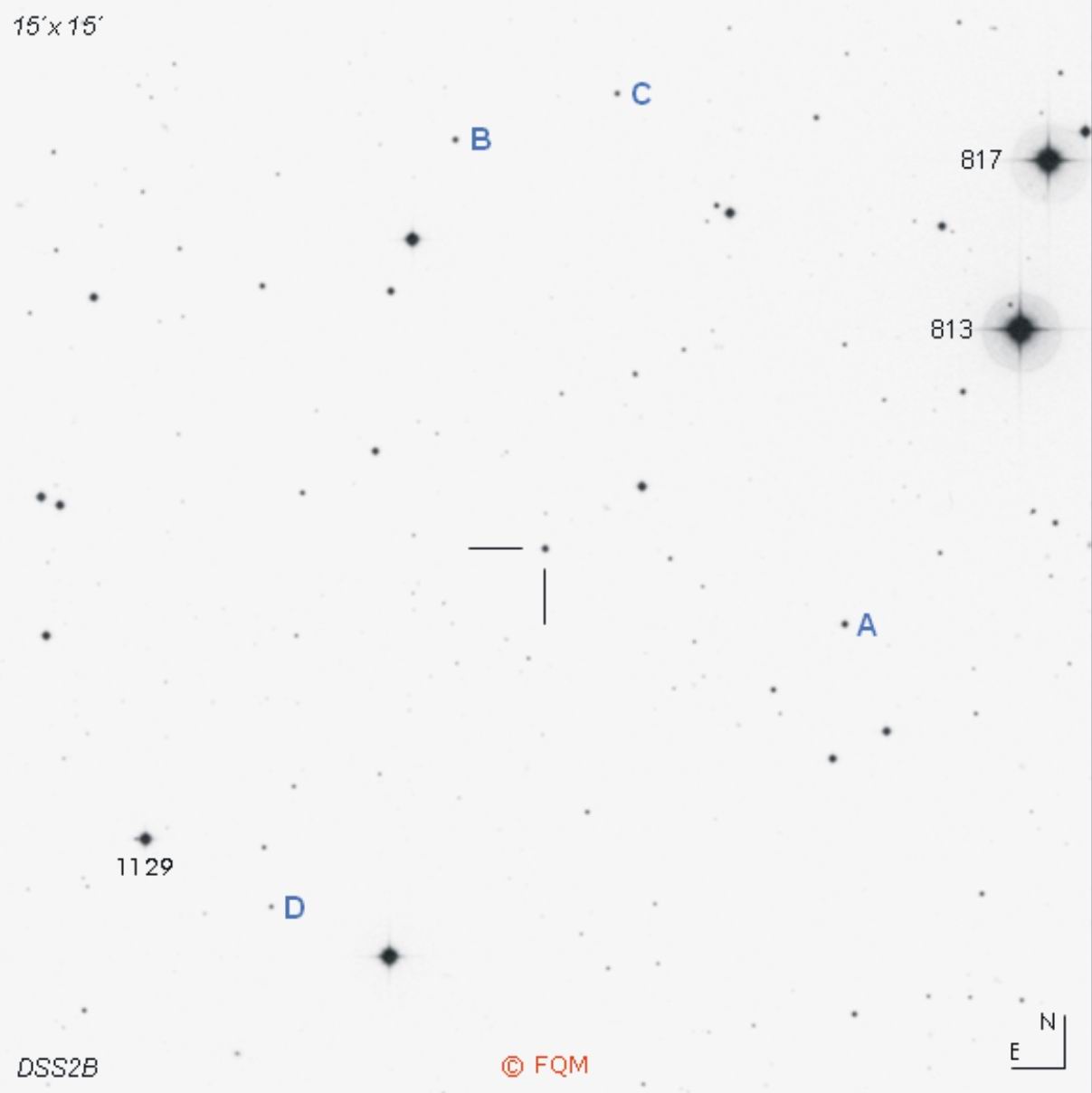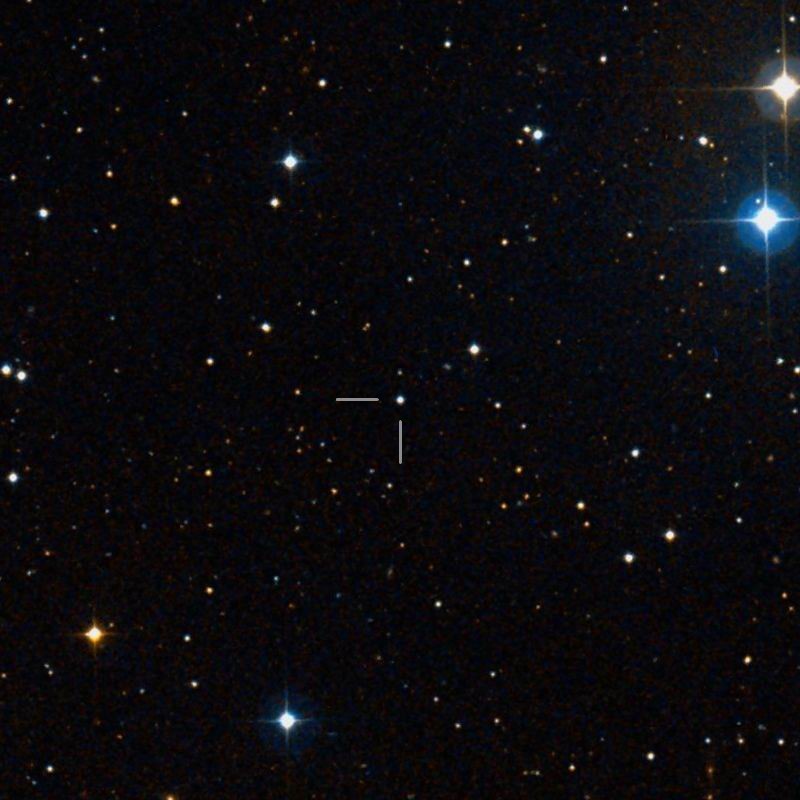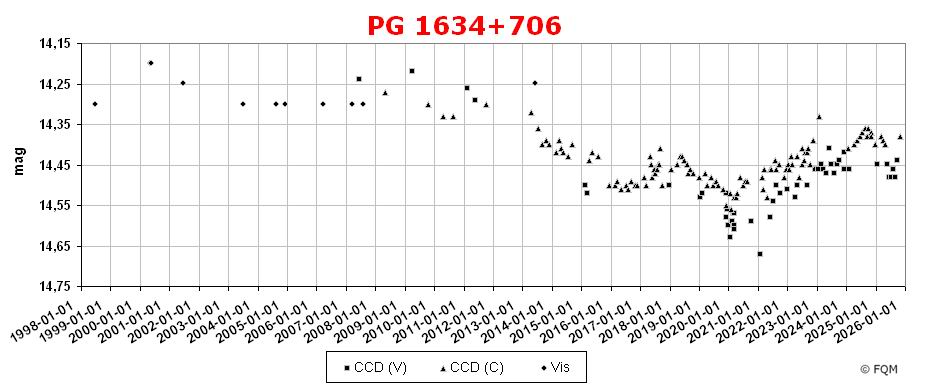
| Frankfurt Quasar Monitoring |
| PG 1634+706 |
| Cross-Identifications | FBS 1634+706, IRAS 16347+7037, 1634+706 2E 1634.9+7037, RX J1634.4+7031, FBS 0908 1RXS J163429.2+703133, QSO B1634+7037 QSO J1634+7031, 2XMM J163428.9+703132 |
| Equat. coordinates | RA 16 34 29.0 DE +70 31 33 (J2000) |
| Constellation | Draco |
| Type | QSO |
| Redshift (1) | z=1.337 (1) / z=1.334 (2) |
| Distance (2) (3) |
3963 Mpc |
| Total mag range (mv) (4) | 14.2 - 14.7 |
| Catalog Magnitude (1) | 15.27p |
| Absolute Magnitude (1) | -29.7 MB |
| Light Travel-Time (2) | 8.633 × 109 yrs |

Comparison stars
| star | V |
| A | 14.23 (0.05) |
| B | 14.70 (0.05) |
| C | 15.21
(0.05) |
| D | 16.10 (0.05) |


| PG
1634+706
is a bright quasar in Draco, about 5.7° NW of Zeta Draconis and close
to the constellation Ursa Minor. PG
1634+706 has a redshift of z=1.337, which means a light travel-time of
8.6×109
years! This is more than half way through the observable universe!
So PG 1634+706 is one of the most luminous objects in the sky.
As such, it was classified as a hyper luminous infrared galaxy
(HyLIRG).
The designation PG 1634+706
refers to the Palomar-Green Bright Quasar Survey (PG), where this object
was discovered as
a blue stellar object between
1976 und 1982. The new point source was immediately identified as a
quasar by spectroscopy.
As a blue stellar object it was also cataloged by the First Byurakan
Spectral Sky Survey (FBS). PG 1634+706 is a low amplitude variable object with a total range of only a few tenths of a magnitude. Visual observers need at least an 8- to 10-inch telescope to glimpse this stellar object. Even with large instruments, the quasar remains stellar. CCD observers, as well as visual observers, may use the comparison stars given above. No photometric sequence has been published to date. V-mag comparison stars A=14.23 and C=15.21 were calibrated from USNO A2.0 catalog, as part of the Frankfurt Quasar Monitoring project. PG
1634+706 is located between
Zeta
(22)
Draconis and the square of Ursa Minor, some 1.8° NNW of star 15
Draconis. An
optical double of two 8-mag stars,
only about 8´NW of the quasar (see
charts above),
is well suited to identify the correct position of PG
1634+706.
____________
Nearly 1° W of quasar PG
1634+706 we find a trio of moderately bright galaxies: Far beyond our Milky Way, in this case about 1.5×109 light-years, quasar MRK 876 is waiting for observers. This bright 15-mag object is located 5° SSE of PG 1634+706. Another bright and variable quasi-stellar object is 3C 371, a bright 14-mag BL Lac object, some 8° E, at a distance of about 0.6×109 light-years.
Only 5´ SE of NGC 6503 (see above), and 6.3°
E of PG
1634+706, another variable BL Lac object shall not be
missed: S4 1749+70,
which is located at a distance of more than 6×109
light-years. That´s quite a lot, so you may like to take a look ! |
| Abramyan, G.B., Mikaelyan, A.M. 1994, Ap, 37, 224A; The First Byurakan Spectral Sky Survey. Blue Stellar Objects. IX. Beyvers, G., Beyvers, C. 2001, SuW 9/01, 773; Quasare im Sechs- und im Achtzöller. Hansen, T. 1991, Deep Sky Magazine 34, 32; The "Deepest" Deep Sky Objects. Karge, S.; Helle Quasare für 8- bis 10-Zoll Teleskope. Ein Beobachtungsführer zur visuellen Beobachtung von Quasaren und BL Lacertae Objekten; Frankfurt 2005. Kirhakos, S.D., Sargent, W.S.W., et al. 1994, PASP, 106, 646; The HST Quasar Absorption-Line Key Project. VIII. CCD Imaging of Hubble Space Telescope Quasar Fields. Richards, G.T., Yanny, B., et al. 1997, PASP, 109, 39R; Quasar Photometry with the SDSS Monitor Telescope. Schmidt, M., Green, R. 1983, ApJ, 269, 352; Quasar Evolution derived from the Palomar Bright Quasar Survey and other complete Quasar Survey. Spevak, J. 1994, Astronomy 7/94, 70; Oh say can you see? Steinicke, W.; Katalog heller Quasare und BL Lacertae Objekte; Umkirch 1998. Steinicke, W. 1999, Interstellarum 15, 42; Unbekannte Quasare für visuelle Beobachter. Véron-Cetty, M.-P., Véron, P. 2001, A&A 374, 92; A Catalogue of Quasars and Active Nuclei: 10th edition. Véron-Cetty, M.-P., Véron, P. 2003, A&A 412, 399; A Catalogue of Quasars and Active Nuclei: 11th edition. Véron-Cetty, M.-P., Véron, P. 2006, A&A 455, 776; A Catalogue of Quasars and Active Nuclei: 12th edition. Véron-Cetty, M.-P., Véron, P. 2010, A&A 518, 10; A Catalogue of Quasars and Active Nuclei: 13th edition. Tytler, D., Fan, X.-M. 1992, ApJS, 79, 1; Systematic QSO Emission-Line Velocity Shifts and New Unbiased Redshifts. |
| Link: Hamburg Quasar Monitoring |
| home |